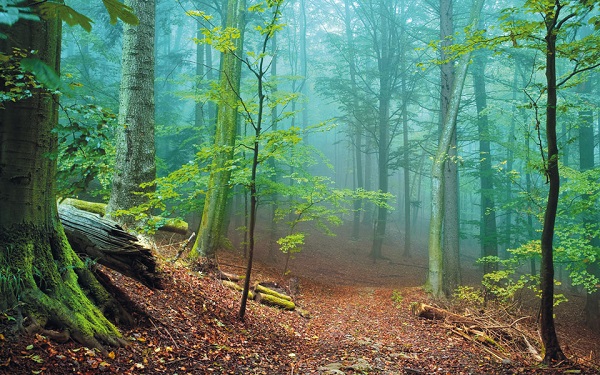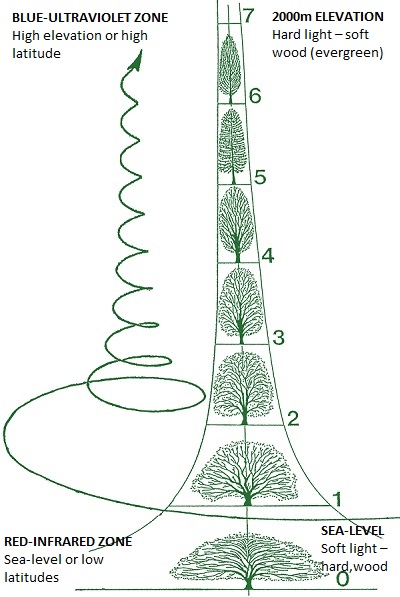“Without a healthy forest there is no healthy water, no healthy blood”
Trees are the Earth’s skin. In many ways, they make all life on Earth possible.
We have been taught that nature is red in tooth and claw, with all creatures competing with one another for light, food and territory, with only the strong surviving. Since we humans really do live in a cold, hard, competitive world, it has been easy to accept this as truth.
New scientific findings, though, show the natural world to be a place of much greater harmony and cooperation than many may have wished to believe. Instead of a constant struggle for survival, evolution has brought forth an immeasurable diversity of species, all of which have their place in the order of things without having to fight for it.

So it is that each species of plant in the forest has its own type of root system. Different types of root tap into all the different layers of soil, drawing water and nutrients up to the surface. This doesn’t just prevent the groundwater level from sinking; it also secures the existence of all creatures. With their deep or broad root systems, plants bind each other to the ground and protect the soil from erosion.
If certain species are missing, some layers of soil can no longer be reached by the roots – and the first cut has been made in the wonderful fabric of the ecosystem. Soon, more rips and holes appear, until finally, species start dying off.
The damage that we have done in our ignorance to the ‘world’s lungs’ over the last few decades is immense; the consequences hard to estimate. And yet the tree is the highest and most noble of plants, whose all-encompassing and unconditional giving supports and nourishes this planet in many ways. Although we differ greatly in outward appearance, trees have much in common with man – we live together in symbiosis. The only difference is that the forests can survive without us, but we cannot survive without them.
This is not just because trees produce the oxygen we need to survive, through photosynthesis. We, and all animals, give trees carbon dioxide in return, which is required by their metabolism. Animals release elements into the air and ground, and transform organic matter into mineral. For their part, plants take elements from the air and ground and transform mineral matter into organic.
Man and Tree Drink Different Light
This cycle of give and take between man and tree manifests itself on another level: that of light and colour. In the visible light spectrum, between ultraviolet and infrared, sunshine is most intense in the blue-green area. Yet it is precisely these frequencies that trees are unable to absorb for their growth, because they cause a sort of torpor, a sleeping inactivity, in them.
Each colour or vibration that cannot be absorbed is reflected. A red surface, for example, absorbs all colour frequencies with the exception of the red ones – so our eyes perceive the red colour that is reflected back. Many of our vital functions are stimulated by particular light frequencies (colours); if these are lacking (neon/artificial light), it can lead to health problems.1

A tree’s shape depends on levitational strength. At low elevations, light is soft and the levitational force weak. The higher the elevation, the stronger the light and levitational force become. The trees become thinner, their wood softer.
Trees are most sensitive to light in the UV and red to infrared frequencies. Trees are almost totally insensitive to green light: if you were to shine just green light on a tree, it wouldn’t grow. The human eye is the complete reverse: ultraviolet and infrared are invisible to us, but we react extremely well to the colour green.
Green doesn’t just relax and strengthen our eyes; it also has a calming – even healing – effect on our nerves and psyche. If we spend too long in an environment that lacks green, we can become irritated or even violent. However, we can’t see the green that is contained in sunlight. Only plants and trees give us this therapeutic green.
In their sensitivity to light, man and tree complement each other like sine and cosine in mathematics, harvesting their life force from the sun’s rays without getting in each other’s way.
We often forget that trees can only adapt slowly. This means that even the slightest environmental variation can kill trees while leaving faster-moving creatures unharmed. We owe trees a great debt of gratitude for their service to all life, a service provided without pause or complaint, even though our depredations have left them weak and vulnerable. Among their other gifts to us, trees stabilise the climate; if more forests had survived to the present day, they would even be capable of distributing humidity evenly across the atmosphere, thereby balancing global temperatures. A full-grown beech, for example, has around seven million leaves, forming a surface of one and a half hectares for the evaporation of water.
Trees Foster Agriculture
Trees don’t just draw moisture and nutrient salts from great depths: they act as protective barriers and give shelter to many other forms of life. Planting these windbreaks (preferably in a spiral) doesn’t just tame the wind; it also keeps the soil from drying out. This gives rise to a microclimate that nourishes the soil with extra humus (leaves), and protects it from erosion. Windbreaks such as these influence evaporation rates on farmland up to 30m against, and 120m with, the wind. Canadian studies have shown that farms with one-third protective tree cover are more productive than farms of the same size that have no tree cover.
These protective barriers also attract carbon dioxide, because it is the heaviest atmospheric gas. Since carbon dioxide is necessary for photosynthesis, all nearby plants grow stronger and better. Consequently, grubbing up hedgerows and cutting down rows of trees doesn’t just rob many birds and other animals of their habitat, it also causes lasting damage to agricultural productivity.
Besides, did you know that you could probably live quite happily with chlorophyll flowing through your veins? As blood is to cellular respiration, so chlorophyll is to photosynthesis in plants. These two bearers of life have an almost identical nitrogen ring in their molecular structure. In chlorophyll, a magnesium atom sits in its centre, giving chlorophyll its green colour, while an iron atom sits within the haemoglobin of red blood cells (complementary colour!). Its 137 atoms make chlorophyll a particularly stable molecule, as 137 is an indivisible prime number. When rats had their blood replaced with liquid chlorophyll, the animals continued to live with ‘plant blood’ as if nothing had happened.
Every physical form is the expression of immaterial energy. The same also goes for trees. Their appearance, inner structure, and lifespan are dependent on invisible energy flows and the interaction of gravity and levitation; the higher their location, the greater the force of levitation (cf. diagram on this page).
Hardwoods and Softwoods
The branches of trees growing near the equator or at low elevations (where the atmosphere is denser and dynamic movement slower, and where harmonically structured energy predominates over dynamic energy) tend to grow horizontally rather than vertically (excepting rainforest trees). These are long-living hardwoods like oaks, beeches, elms, and so forth, which tend to live for between 200 and 800 years. They are an expression of a denser, less dynamic energy field and a weak upwardly-directed energy spiral (levitational force).
The higher the elevation and/or the higher the latitude, the thinner the trees become, reflecting the difference in this upwardly-directed energy. As gravity weakens and levitational force strengthens with increased altitude, so atmospheric density also lessens, while the dynamic movement in the energy field increases. Trees such as pines, larches, firs, and spruces, with soft wood and shorter lifespans of 120 to 300 years, mirror the rapid upward movement of levitation. Their natural life is shorter, because they are exposed to higher-frequency, faster-vibrating light. Light zones change with elevation and latitude: under normal circumstances, softwoods like pines will be found at low elevations and high latitudes, or at high elevations and low latitudes, while hardwoods will mostly be found at low to moderate elevations and latitudes.
Trees are also a mirror image of the light that nourishes them. The colour of their leaves and trunk indicates which light spectrums they can’t absorb and hence reflect. Australian saplings mostly show a special mix of the colours red, violet, and blue; while in Europe, where quite different light conditions prevail, most have a light-green colour.
An additional rule of thumb: the greater the proportion of high-frequency, UV sunlight – the harder the light – the softer the wood; and the other way round: the greater the low-frequency, infrared proportion of colours – the softer the light – the harder the wood. Hence the reason Australia is known for its extremely hard woods – due to its geographic location and huge areas of semi-desert, it is exposed to a particularly high proportion of infrared sunlight.
Logically, we ought to find hardwoods in the forests around the equator too, yet some types of tree there, balsa for example, have extremely soft wood. It becomes clear why if we bear in mind that our ‘normal’ light spectrum, between infrared (soft light) and UV (hard light), makes up only a small part of total sunlight. Beyond ultraviolet lie innumerable frequencies. These soon reach the higher vibrational octave of visible red. Just as two octave tones immediately vibrate with one another, there is also a direct resonance between an infrared and an ultraviolet frequency.
This means that the light frequency determining the quality of the wood on the equator must already lie very strongly in the infrared frequency. This causes a sudden resonance with ultraviolet vibrations, creating softwood rather than hardwood. Because this resonance pertains to a different octave, the corresponding wood is also significantly softer. Balsa, for example, is the softest wood of all.
The Water Cycle
When rain falls, individual water molecules spiral down to the ground, absorbing increasing volumes of atmospheric oxygen, nitrogen and other gases as they do so. At the same time, they generate strong bio-
electric and biomagnetic fields. They transfer this tension (life force) to the plants, as well as the accumulated oxygen and other gases, which are taken up by the leaves and the ground. Together with etheric energies, they stimulate accelerated growth, and many transformation processes. As a result, plants respond much more positively to rain than to conventional irrigation, where the water droplets logically fall a much shorter distance. They haven’t been exposed to the constructive, noble, and ethereal vibrations of the sun that are found at a height above 4,000m. It therefore makes good sense to collect rainwater in a water butt.
When rainwater reaches the ground with a positive temperature change (cooling – cf. FaF12, articles on water), rainwater penetrates the ground, and surplus oxygen is slowly absorbed by the soil. This stimulates life in the humus, which is teeming with microorganisms. As the water seeps into deeper strata, cooling toward 4°C, it sheds its last excess oxygen. At these depths, chemical reactions between magnesium, calcium, carbon dioxide, and water form magnesium and calcium carbonates, releasing hydrogen. The temperature being so low, the freed oxygen is easily captured by the hydrogen atoms, forming new water. It therefore follows that the available volume of water on this planet is not fixed.
This fresh water is completely pure. Born at 4°C – water’s anomaly point (its point of highest energy density) – and truly young and immature, it rises ever upward through the fine energy and temperature layers, continually learning from the resonances and vibrations that it gathers along the way. It also gradually warms as it continues on its upward journey, dissolving more and more minerals, salts, and trace elements. These are ionised and converted into a form that plants and microorganisms can use.
The water is now ready to give to life instead of taking from it. It has matured and forms life-giving molecular chains. That’s why spring water is much healthier to drink than groundwater (cf. FaF12). At the precise point where this risen groundwater is ready to release its full power and give to life, we can find the next young, ‘taking’, and information-seeking systems: the fine hairy roots of plants, with their microorganisms. These assemble the nutrients into larger molecules.
These are then drawn up through fine capillaries along with the ‘adult’ macro water molecules into the ever broader channels of the roots, and deposited. As soon as the surface is reached, the provision of nutrients from outside the plant suddenly stops. This is where the boundary between the invisible world of the root zone and the sunlit visible, energetic world lies. It is here on the surface that the tree’s two supply systems, the visible and the invisible, unite.
Sources
- 1 cf. FaF3, p.46 "Biology of Light"






